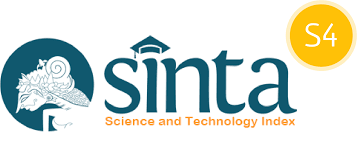Analisa Prediksi Kesejahteraan Masyarakat Nelayan Lombok Timur Menggunakan Algoritma Random Forest
DOI:
https://doi.org/10.29408/jit.v6i2.10104Keywords:
Classification, Pediction, Random ForestAbstract
The economic life of the people on the coast, especially fishermen, is very dependent on the natural resources that are around, for example, marine resources, which still get the top position in the survival of fishing communities which are widely used and are also included as renewable natural resources. One example used as material for this research is the fishing community in East Lombok, West Nusa Tenggara. The Fishermen's Community can be interpreted as a group of people whose main livelihood is fishermen. The characteristics of the life of this community are different from society in general. Natural factors influence their lives a lot, from their lifestyle to the level of their economy and welfare, which is different from other communities. The purpose of this study is to predict the level of welfare of fishing communities in East Lombok, West Nusa Tenggara by using the classification method and the Random Forest algorithm. The dataset used is private data, the data is taken from fishing applications. Data processing is done to get the result or performance of the algorithm as the best result in predicting. From the existing dataset we use five supporting variables including, Education, family members, wells (related to clean water), employment and housing. The results or targets of this data processing are the level of welfare of fishing communities with prosperous and non-prosperous statuses. The final results of this study are seen using the Confusion Matrix, where the end result is the accuracy value. Random Forest has the highest accuracy value with a value of 93.37% and an AUC value of 0.735%.
References
S. Wiranto, “Membangun Kembali Budaya Maritim Indonesia Melalui Kebijakan Kelautan Indonesia dengan Strategi Pertahanan Maritim Indonesia : Perspektif Pertahanan Maritim,” pp. 110–126, 2020.
N. A. Nugroho, “Perbandingan Algoritma Machine Learning dalam Pengklasifikasian Tingkat Kemiskinan di Indonesia Tahun 2021,” vol. 6274, pp. 1–12, 2022.
N. S. Rahmi, “HUBUNGAN PATRON-CLIENT DAN RITUAL PETIK LAUT - Studi Kasus Masyarakat Desa Tanjung Luar , Kabupaten Lombok Timur , Nusa Tenggara Barat Oleh Nurbayu Sutiya Rahmi Program Magister Sumber Daya Pantai Universitas Diponegoro.”
M. M. Mutoffar and A. Fadillah, “KLASIFIKASI KUALITAS AIR SUMUR MENGGUNAKAN,” vol. 04, no. 02, pp. 138–146, 2022.
F. F. Veronica Retno Sari, “PERBANDINGAN PREDIKSI KUALITAS KOPI ARABIKA DENGAN MENGGUNAKAN ALGORITMA SGD, RANDOM FOREST DAN NAIVE BAYES,” EDUMATIC, vol. 4, no. 2, pp. 1–9, 2020, doi: 10.29408/edumatic.v4i2.2202.
E. Christy and K. Suryowati, “ANALISIS KLASIFIKASI STATUS BEKERJA PENDUDUK DAERAH,” vol. 6, no. 1, pp. 69–76, 2021.
M. Rianto and R. Yunis, “Analisis Runtun Waktu Untuk Memprediksi Jumlah Mahasiswa Baru Dengan Model Random Forest,” vol. 23, no. 1, 2021.
B. Prasojo and E. Haryatmi, “Analisa Prediksi Kelayakan Pemberian Kredit Pinjaman dengan Metode Random,” vol. 02, pp. 79–89, 2021.
A. Y. Perdana, R. Latuconsina, A. Dinimaharawati, and U. Telkom, “PREDIKSI STUNTING PADA BALITA DENGAN ALGORITMA RANDOM,” vol. 8, no. 5, pp. 6650–6656, 2021.
S. Linawati and S. Nurdiani, “PREDIKSI PRESTASI AKADEMIK MAHASISWA MENGGUNAKAN,” vol. VIII, no. 1, pp. 47–52, 2020.
C. I. Agustyaningrum, W. Gata, R. Nurfalah, and U. Radiyah, “KOMPARASI ALGORITMA NAIVE BAYES , RANDOM FOREST DAN SVM UNTUK MEMPREDIKSI NIAT,” vol. 20, no. 2, 2020.
M. Azhari, “Perbandingan Akurasi , Recall , dan Presisi Klasifikasi pada Algoritma C4.5,Random Forest, SVM, dan Naive Bayes,” vol. 5, no. April, pp. 640–651, 2021, doi: 10.30865/mib.v5i2.2937.
M. Julkarnain, K. R. Ananda, and P. D. Ternak, “SISTEM INFORMASI PENGOLAHAN DATA TERNAK UNIT PELAKSANA,” vol. 2, no. 1, pp. 32–39, 2020.
M. Asrol, P. Papilo, and F. E. Gunawan, “ScienceDirect Procedia ScienceDirect ScienceDirect Support Vector Machine with K-fold Validation to Improve the Support Vector Machine with K-fold Validation to Improve the Industry ’ s Sustainability Performance Classification Industry ’ s Sustainability,” Procedia Comput. Sci., vol. 179, no. 2020, pp. 854–862, 2021, doi: 10.1016/j.procs.2021.01.074.
A. Residencia, “KLASIFIKASI KELAYAKAN PESERTA PENGAJUAN KREDIT RUMAH DENGAN ALGORITMA NAÏVE BAYES DI PERUMAHAN AZZURA RESIDENCIA,” vol. 9, pp. 43–48, 2019.
L. M. Samsu and W. Amnia, “Implementasi Algoritma Naive Bayes Untuk Klasifikasi Penerima Beasiswa ( Studi Kasus Universitas Hamzanwadi ),” vol. 6, no. 1, 2023.
R. Novitrii and N. Irawati, “INTEGRASI METODE NEIVE BAYES DAN SOFTWARE RAPIDMINER DALAM ANALISIS HASIL USAHA PERUSAHAAN DAGANG Rika Nofitri , Novica Irawati Sekolah Tinggi Manajemen Infromatika dan Komputer Royal,” vol. VI, no. 1, pp. 35–42, 2019.
M. S. LM Samsu and H.Bahtiar, “Komparasi Algoritma Denoising Dan Binarization Dengan Adaptive Thresholding Dan Morfologi Untuk Menigkatkan Kualitas Keterbacaan Citra Naskah Lontar (Takepan) Sasak,” Infotek J. Inform. dan Teknol., vol. 3, no. 2, pp. 121–127, 2020.
H. B. Suhartini, “Klasifikasi Algoritma K-Nearest Neighbor Berbasis Particle Swarm Optimization Untuk Kelayakan Bantuan Rehabilitasi Rumah Tidak Layak Huni Pada Desa Lenek Duren Kecamatan Aikmel Kabupaten Lombok Timur,” Infotek J. Inform. dan Teknol., vol. 2, no. 2, pp. 5–10, 2019.
Downloads
Published
How to Cite
Issue
Section
License
Semua tulisan pada jurnal ini menjadi tanggung jawab penuh penulis. Jurnal Infotek memberikan akses terbuka terhadap siapapun agar informasi dan temuan pada artikel tersebut bermanfaat bagi semua orang. Jurnal Infotek ini dapat diakses dan diunduh secara gratis, tanpa dipungut biaya sesuai dengan lisense creative commons yang digunakan.
Jurnal Infotek is licensed under a Creative Commons Attribution 4.0 International License.
Statistik Pengunjung




